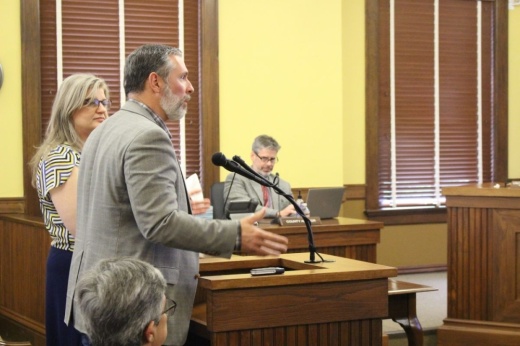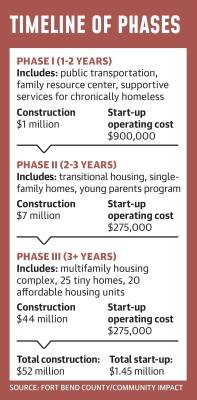On Feb. 28, executives of local nonprofits asked Fort Bend County Commissioners Court to reallocate $13 million in federal funds given to the county for a multiphase transitional housing program. If approved, the program could build multifamily duplexes and a centralized resource center as well as hire staff to help homeless individuals.
On Feb. 14, the court approved the transfer of $2 million to its Emergency Rental Assistance budget for the purpose of this program. The nonprofits aim to use the rest of the requested funds as a down payment to kick-start the program, they said, and hope to use future Community Development Block Grant funding for the remaining $40 million.
During the Feb. 28 meeting, Precinct 1 Commissioner Vincent Morales said there was a need for a program like the one proposed but urged the court to take more time to work with the budget office to flesh out the remaining balance in the American Rescue Plan Act funding pot.
However, County Judge KP George was eager to dedicate the resources and said the county has a “once-in-a-lifetime chance” to address the issue of homelessness.
“These [groups] mentioned here, they are all waiting for our move. They are saying, ‘OK, you’re lecturing about poverty, then put some money where your mouth is,’” he said.
There were 14,120 households in Fort Bend County vulnerable to becoming homeless because they only earn up to 30% of the county’s area median income, according to a homeless-needs inventory and gap analysis the county drafted in late February.
It also found that due to a rental shortage in the county, housing options for people at risk of homelessness are few. The analysis identified emergency shelters as first priority for homeless individuals and families.
Vera Johnson, executive director for Fort Bend Family Promise, said the program has been needed for a while.
“This project has been a long time coming,” she said. “But we’re confident that we’ll be able to do a great deal of good for our Fort Bend residents.”
Emergent need
Currently there are only two emergency shelters within the county—exclusively for at-risk youth or women.
Data from Fort Bend ISD showed homelessness may be an issue for the county’s youth as well. In the district, there were a reported 935 homeless students in the 2021-22 school year.
Nine local organizations collaborated on the housing solution for Fort Bend County, and full cooperation will be needed from all parties to fully utilize county funding, Johnson said. She said Fort Bend Family Promise hopes the funding will target three areas: diversion housing, resource matching and Project BUS—which stands for “bridging us to services.”
“We want to make sure that we can connect people with resources they might not know about,” Johnson said. “We brought to the table ‘Project BUS’—bridging us to services—which is working with transportation that would run a route throughout the county that would stop off at various nonprofits and would make it to the project that we hope to build.”
In all, the program incorporates emergency shelter; transitional housing; supervised independent living for youth aging out of foster care; and supportive, permanent housing for individuals with major behavioral or health needs.
“This project includes case management, workforce development, education support—all of those things are so vitally important, and we need to make sure that we are getting to the root of each family’s challenges and their crises,” said Shannan Stavinoha, executive director for Parks Youth Ranch.
It also would supply affordable rental housing structured as multifamily housing, where residents would not spend more than 30% of their pretax income on housing, as well as affordable homeownership—which would include homebuyer education and down payment assistance programs.
Precinct 4 Commissioner Dexter McCoy applauded the groups’ efforts to encompass homeownership into its programming but said he would not support removing federal funding from other initiatives.
“We have been let down by the state of Texas before in giving necessary funds for infrastructure, and I want to make sure we have this to be able to really help those people who, on the ground today, need that help,” he said.
Current allocations
The three budgets the nonprofits are requesting federal funds from are the Home American Rescue Plan, American Rescue Plan Act and Emergency Rental Assistance. The county received these one-time allocations to provide relief from COVID-19.
The transitional housing plan would require the county to reallocate $8 million from its ARPA budget as well as $2 million from its ERA budget, which commissioners approved the transfer of on Feb. 14, Fulshear Mayor Aaron Groff said.
Groff also serves as the executive director of Abigail’s Place, an organization that houses single mothers and their families.
Additionally, the nonprofits requested to use $3 million from the Home American Rescue Plan budget, a portion of Community Development Block Grant funding received from the U.S. Department of Housing and Urban Development in 2021. Community Development Director Carol Borrego, who manages CDBG and Home ARP funds, advised the court that HUD money should be the last dollars considered—as restrictions for their use will be stringent, she said.
Precinct 3 Commissioner Andy Meyers said he did not consider the reallocation to a transitional housing program a viable use of funds.
“Providing the services are not typical county services,” Meyers said. “These are services that are provided by the federal and state agencies, since they have additional revenue sources that the county does not have.”
After Stavinoha’s Feb. 28 presentation, George again implored the court to take action on this issue.
“We had $157 million from ARPA funding. We are talking about $8 million investing in the future of our children and the homeless,” George said. “If we have a hard time doing that, I don’t know what else to say.”
Groff, who said he understands some of the commissioners’ hesitation to reallocate funding, wanted to ensure the requested funds were a bid to better use federal moneys and not county dollars.
“[The] number and allocation is entirely up to you—that’s not our ask,” Groff said. “Our ask is, if we can leverage those [federal] dollars to make a long-term impact in the county, then we can use this as a model for sustainable projects moving forward.”








